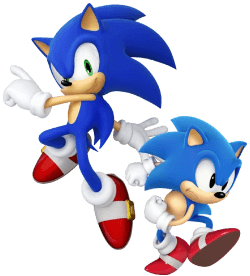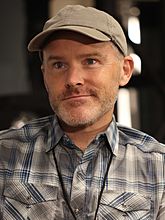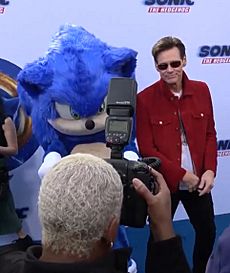Sonic the Hedgehog (character) facts for kids
Quick facts for kids Sonic the Hedgehog |
|
|---|---|
| Sonic the Hedgehog character | |

Modern (left) and Classic (right) Sonic designs as they appear in Sonic Generations (2011)
|
|
| First appearance | Rad Mobile (1991) |
| First game | Sonic the Hedgehog (1991) |
| Created by | |
| Designed by |
|
| Voiced by |
Japanese
Takeshi Kusao (1991–1993)
Toshio Furukawa (commercials) Masato Nishimura (Sonic the Hedgehog CD) Masami Kikuchi (1996 OVA) Jun'ichi Kanemaru (1998–present) Tomokazu Seki (Sonic Unleashed; "Werehog" form) Taishi Nakagawa (live-action films) English
Jaleel White (Adventures of Sonic the Hedgehog, Sonic the Hedgehog, Sonic Underground)
Meg Inglima (Sonic's Schoolhouse) Paula Arundell (Sonic Live in Sydney) Martin Burke (1996 OVA) Ryan Drummond (1998–2004) Sam Vincent (Sonic Underground; singing voice) Jason Griffith (2003–2010) Roger Craig Smith (2010–present) Ben Schwartz (live-action films) Benjamin L. Valic (Young Sonic, 2020 film) Deven Mack (Sonic Prime) |
| Information | |
| Species | Hedgehog |
| Gender | Male |
| Age | 15 |
| Weight | 35 kg (77 lb) |
Sonic the Hedgehog is a famous character from video games. He was created by Naoto Ohshima and Yuji Naka. Sonic is the main hero of Sega's Sonic the Hedgehog video game series. He is a blue hedgehog who looks like a human (this is called anthropomorphism). Sonic can run super fast, faster than sound! He can also curl into a ball to attack his enemies. In his games, he speeds through levels, collects shiny rings, and tries to stop the evil mad scientist Doctor Eggman.
Sonic first appeared briefly in the arcade game Rad Mobile in 1991. His first full game was Sonic the Hedgehog for the Sega Genesis in 1991. Naoto Ohshima designed Sonic to be Sega's main character, like Nintendo's Mario. Yuji Naka helped make Sonic's fast-moving gameplay. Later, Yuji Uekawa changed Sonic's look for Sonic Adventure (1998). This new design was more grown-up to appeal to older players.
Sonic is one of the most well-known video game characters in the world. He is a true gaming icon. By 2011, his game series had sold over 80 million copies!
Contents
How Sonic Was Created

Sega wanted a main character to compete with Nintendo's Mario. So, their design team came up with many ideas. Some ideas included an armadillo, a dog, and even a rabbit. There was also a character like Theodore Roosevelt in pajamas, who later became the bad guy, Doctor Eggman.
Naoto Ohshima took some of these designs to New York City. He asked people in Central Park what they thought. The spiky blue hedgehog, first called "Mr. Hedgehog," was the most popular. People liked it because it seemed to fit everyone. When Ohshima returned to Japan, the hedgehog was chosen as Sega's new main character.
Sonic's design was made to be easy for children to draw. He also looked "cool," which was popular in the United States at the time. Sonic's blue color matches Sega's blue logo. His red shoes were inspired by Michael Jackson's boots and the colors on his 1987 album Bad. Sonic's personality was based on Bill Clinton's "Get it done" attitude.
The idea for Sonic also came from Yuji Naka. He made a tech demo where a character could roll smoothly on curves. This fast-rolling idea was then combined with Ohshima's character design and levels by Hirokazu Yasuhara.
Sonic was created without the ability to swim. This was because Yuji Naka mistakenly thought all hedgehogs couldn't swim. A team of fifteen people worked on the first Sonic the Hedgehog game. They called themselves Sonic Team. The music for the game was made by Masato Nakamura. Early ideas for Sonic included fangs and a human girlfriend named Madonna. But a team from Sega of America changed these to make him more kid-friendly.
Sonic's look has changed over time. His first design by Ohshima was short and round. For Sonic Adventure (1998), Yuji Uekawa redesigned him. He became taller with longer legs and green eyes. For the 2006 game, Sonic was made even taller to look more adult. This was so he would fit in better when interacting with human characters. In Sonic Unleashed, Sonic could turn into a "Werehog." This form made him strong but slower.
Who Voices Sonic?

Sonic first had a few voice clips in Sonic CD. His first real voice actor in Japan was Takeshi Kusao. Since 1998, Junichi Kanemaru has been the main Japanese voice for Sonic. He also voices Sonic in Sonic X and Sonic Boom.
In English, Ryan Drummond voiced Sonic starting with Sonic Adventure. Later, Jason Griffith took over. Since 2010, Roger Craig Smith has been the voice of Sonic in most games. In the live-action movies, Ben Schwartz voices Sonic. For the Sonic Prime animated series, Canadian actor Deven Mack voices him.
Sonic's Adventures in Games
Sonic first appeared in a video game as a small decoration. This was in the 1991 arcade racing game Rad Mobile. His first game where you could play as him was Sonic the Hedgehog for the Sega Mega Drive/Genesis. This game also introduced his enemy, Dr. Robotnik.
Sonic's two-tailed fox friend, Tails, joined him in Sonic the Hedgehog 2 (1992). In Sonic CD (1993), Sonic met Amy Rose, who became his self-appointed girlfriend. He also met his robot copy, Metal Sonic. Sonic 3 and Sonic & Knuckles (both 1994) saw Sonic and Tails fight Robotnik again. They also met Knuckles, who was tricked by Robotnik.
Many other 2D platform games starring Sonic were made for handheld consoles. These include Sonic Advance (2001) and Sonic Rush (2005).
Sonic Adventure (1998) was a big step for Sonic. It was his first major 3D game. In this game, Sonic returns from vacation to find a new enemy, Chaos. Sonic Adventure 2 (2001) had Sonic on the run from the military. He was mistaken for Shadow the Hedgehog. In Sonic Heroes (2003), Sonic teamed up with Tails and Knuckles. They fought against Metal Sonic, who wanted to take over the world.
In Sonic Unleashed (2008), Sonic became "Sonic the Werehog." This gave him strength but made him slower. In Sonic Colors (2010), Eggman tried to use alien beings called "Wisps." Sonic Generations (2011) let players control two versions of Sonic. There was the younger "classic" Sonic and the modern Sonic. They went through levels from past games.
Sonic has also appeared in many other types of games. These include racing games like Sonic Riders (2006) and fighting games like Sonic Battle (2003). He even appeared in a role-playing game called Sonic Chronicles: The Dark Brotherhood (2008).
Guest Appearances and Team-Ups
Sonic often appears in other games. He is a playable character in the Super Smash Bros. series. He also teams up with Mario in the Mario & Sonic at the Olympic Games series. Sonic has also appeared in Lego Dimensions (2015) and Cookie Run: Kingdom (2021). You can even find a Sonic costume in the game Fall Guys.
Sonic in Cartoons and Movies
Animated Shows
The first cartoons about Sonic were made by DiC. Adventures of Sonic the Hedgehog (1993) showed Sonic and Tails fighting Doctor Robotnik. Another show, Sonic the Hedgehog (also 1993), showed Sonic as a rebel fighting Robotnik. Sonic Underground (1999) featured Sonic and his siblings.
In 2003, a new anime series called Sonic X began. It had 78 episodes. Sonic worked to protect the Chaos Emeralds from Eggman. Sonic also made cameo appearances in the Disney movies Wreck-It Ralph and Ralph Breaks the Internet.
In 2013, Sega announced a new CGI cartoon, Sonic Boom. It ran from 2014 to 2017. In 2021, Netflix announced Sonic Prime, which came out in 2022. In this show, Sonic accidentally breaks a special prism. This creates many different versions of his friends. Sonic must find the pieces of the prism to fix everything.
Live-Action Movies

A live-action movie based on Sonic was announced in 2014. It was called Sonic the Hedgehog. The movie mixes live actors with CGI for Sonic. It was filmed in 2018. When the first trailer came out, fans didn't like Sonic's look. So, the director, Jeff Fowler, decided to redesign him. This pushed the movie's release date to February 14, 2020. The new design was much more popular!
In the first movie, Sonic has super speed powers. He becomes friends with a sheriff named Tom Wachowski. They work together to stop the evil Dr. Robotnik. Robotnik wants Sonic's speed for world domination. A sequel, Sonic the Hedgehog 2, came out on April 8, 2022. In this movie, Sonic and Tails try to stop Robotnik and Knuckles from getting the powerful Master Emerald.
Sonic also appeared briefly in the 2018 movie Ready Player One.
Comic Books
Sonic first appeared in a comic book given away with Disney Adventures magazine. This comic explained how Sonic got his blue color and powers. It also showed how a kind scientist became the evil Dr. Ivo Robotnik. Many British comics used this story.
In America, Archie Comics published Sonic the Hedgehog comics from 1993 to 2017. This series was based on the older animated TV shows. It became one of the longest-running comic series based on a video game. Later, a new comic series by IDW Publishing started in 2018.
Sonic has also been in two different manga series in Japan. One was about a normal hedgehog boy named Nicky who could turn into Sonic.
Sonic's Personality and Powers
Official information from Sega describes Sonic as being "like the wind." He lives freely and loves adventures. Sonic hates unfairness and always stands up for freedom. He is usually quick-witted and relaxed. But he can get impatient with things that are too slow. Sonic is a brave hedgehog who is honest and loyal to his friends. He always keeps his promises. He took the young Tails under his wing like a little brother. When things get tough, Sonic becomes very focused.
Sonic's biggest strength is his super speed. He is known as the fastest hedgehog in the world. Many of his moves come from how hedgehogs roll into a ball for protection. He adds spinning to this. His main attack is the "Spin Attack." Later games added the "Spin Dash," where he spins in place before blasting off. The "Homing Attack" lets Sonic dash towards an enemy in midair.
Sonic's only weakness is that he cannot swim. He sinks like a rock in deep water. This is because his creator, Yuji Naka, thought hedgehogs couldn't swim. However, in some old storybooks, he could swim.
When Sonic collects the seven Chaos Emeralds, he can change into "Super Sonic." In this form, he is faster, stronger, and cannot be hurt. His eyes turn red and his body becomes golden.
See also
 In Spanish: Sonic (personaje) para niños
In Spanish: Sonic (personaje) para niños

